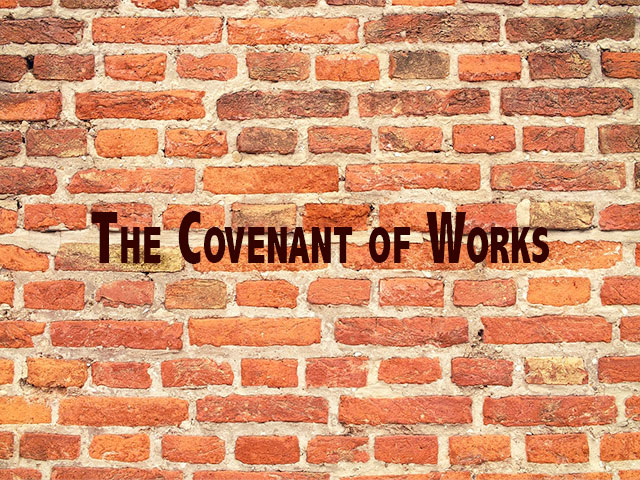The Covenant of Works
From TABLETALK
by J.V. Fesko
By themselves, individual bricks look nothing like a completed building. But joined together, each individual brick is one smaller part of a greater assembled whole—a building. We can say the same about the surveyed scriptural data: the gathered scriptural data provides the building blocks for assembling the doctrine of the covenant of works. The two parties of the covenant are the triune God and Adam, which is especially evident in the opening creation narrative—no one else is present. The conditions of the covenant are clear. Adam was supposed to obey God’s commands: the command to be fruitful, multiply, fill all the earth, and subdue it (Gen. 1:28) and the command not to eat from the Tree of Knowledge (2:16–17). God told Adam that if he disobeyed, he would die. The contrariwise blessing is implicit in the threat of death—namely, life. God exiled Adam and Eve from the garden, “lest he reach out his hand and take also of the tree of life and eat, and live forever” (3:22). Thus, had Adam obeyed, God would have eventually permitted him to eat from the Tree of Life and secure eternal life for himself and for his offspring upon the completion of his test. Westminster Confession 7.2 draws the connection between life and obedience: “The first covenant made with man was a covenant of works, wherein life was promised to Adam; and in him to his posterity, upon condition of perfect and personal obedience.” To support this statement, the Westminster divines cite Galatians 3:12 and Romans 10:5.
Paul writes: “But the law is not of faith, rather ‘The one who does them shall live by them’” (Gal. 3:12), and “For Moses writes about the righteousness that is based on the law, that the person who does the commandments shall live by them” (Rom. 10:5). In both verses, Paul appeals to and explains Leviticus 18:5, “You shall therefore keep my statutes and my rules; if a person does them, he shall live by them: I am the Lord.” Paul quotes this verse to show that in the doctrine of justification, faith and works stand in antithesis. When God justifies a person, He declares him righteous—that is, he is in conformity with the requirements of the law. Paul explains that there are only two paths to a good verdict: either perfect obedience to the law or faith in Jesus Christ. Under the covenant of works, Adam had to secure eternal life through his perfect, personal, and perpetual obedience to God’s commands. This is why Leviticus 18:5—“If a person does [the commandments], he shall live by them”—is relevant to the covenant of works, especially considering Paul’s use of this verse in Romans and Galatians. Paul simply echoes the teaching of Jesus on this vital point.
Under the covenant of works, Adam had to secure eternal life through his perfect, personal, and perpetual obedience to God’s commands.
When Jesus was teaching, a lawyer stood up and asked Him, “Teacher, what shall I do to inherit eternal life?” (Luke 10:25). Jesus responded: “What is written in the Law? How do you read it?” (v. 26). The lawyer answered by quoting the first and second greatest commandments: “You shall love the Lord your God with all your heart and with all your soul and with all your strength and with all your mind, and your neighbor as yourself” (v. 27; cf. Deut. 6:4–6; Lev. 19:18). How did Jesus respond? He quoted Leviticus 18:5: “You have answered correctly; do this, and you will live” (Luke 10:28, emphasis added). Jesus, of course, did not undermine the gospel in any way with His response. Rather, He simply explained how the law works: obey perfectly, and you receive the promised reward of the covenant of works, eternal life. But what Jesus did not tell the lawyer was whether he could, sinner that he was, perfectly obey the law. We know, of course, that sinners cannot, “for all have sinned and fall short of the glory of God” (Rom. 3:23). That all people are sinners turns us to a crucial element of the covenant of works—namely, the doctrine of imputation.
The Apostle Paul explains how Adam’s actions affected all human beings: “Therefore, . . . sin came into the world through one man, and death through sin, and so death spread to all men because all sinned” (Rom. 5:12). When Adam sinned, all people sinned. Yet how is this possible? Why does God hold all people accountable for Adam’s actions? Adam was our covenantal, or federal, representative. The Latin word for “covenant” is foedus, from which we get the word federal. In a representative republic such as the United States, voters elect senators, for example, to represent their state’s interests in the nation’s capital—they are federal representatives. In this case, God created Adam and appointed him as our federal representative. Paul contrasts the representative actions of the two covenantal heads, Adam and Christ: “Therefore, as one trespass led to condemnation for all men, so one act of righteousness leads to justification and life for all men. For as by the one man’s disobedience the many were constituted sinners, so by the one man’s obedience the many will be constituted righteous” (vv. 18–19, author’s translation). When Adam sinned, he placed everyone whom he represented into the category of sinner; conversely, God places all those whom Christ represents into the category of righteous. In more technical terms, God imputes (or credits) Adam’s sin to all his offspring and imputes Christ’s obedience and suffering to those who believe in Him.
Finally, the signs of the covenant of works are the two trees: the Tree of Knowledge of Good and Evil and the Tree of Life. We must not think that these trees had any poisonous or magical qualities, that once consumed their fruit would impart either death or life. Rather, remember that God’s revelation follows the word-act-word pattern. God speaks His word, He gives His revelation in some action, and then He speaks His interpretive word to explain His word and action. God is His own interpreter. In this case, when God gave His command to Adam, He gave it with an accompanying visible sign, the Tree of Knowledge. The Tree of Knowledge is a visible manifestation of God’s command, His law. It should not surprise us, then, that the Tree of Knowledge bears a likeness to God’s law. When the serpent tempted Eve to eat from the tree, Eve beheld it and “saw that the tree was good for food, and that it was a delight to the eyes, and that the tree was to be desired to make one wise” (Gen. 3:6, emphasis added). This is how the psalmist characterizes God’s law: “The law of the Lord is perfect, . . . making wise the simple . . . , enlightening the eyes” (Ps. 19:7–8). The Tree of Knowledge was a visible sign of the covenant, a reminder of God’s covenantal command, and it would indeed make Adam and Eve wise if they feared the Lord and obeyed His command. Conversely, the Tree of Life was a visible form of God’s implicit promise to give Adam and his offspring eternal life upon the completion of his labors. The trees were sacred signs, or sacraments, of God’s word—the promise of life and the threat of death.
Above all else, the covenant of works showcases love—God’s love for Adam and the opportunity for Adam to love God.
God created and entered into a covenant with Adam, but like the covenant of redemption, this agreement was not a cold business transaction. In our culture, obedience is virtually a curse word—waving a verbal white flag that one surrenders his rights or that someone robs another of his will to live as he chooses. The Bible paints obedience in an entirely different light. Covenant, law, and love meet and embrace in the first and greatest commandment: “Hear, O Israel: The Lord our God, the Lord is one. You shall love the Lord your God with all your heart and with all your soul and with all your might. And these words that I command you today shall be on your heart” (Deut. 6:4–6). Obedience and love go hand in hand. Equally, the covenant of works was the arena of God’s love. Although 1 Samuel 18:3 records these words about Jonathan’s covenant with David, they also say as much about God’s covenant with Adam: “Then Jonathan made a covenant with David, because he loved him as his own soul.” God showered Adam in blessings and His love. Above all else, the covenant of works showcases love—God’s love for Adam and the opportunity for Adam to love God. But sadly, we all know the bitter and dreadful outcome of the covenant of works. The prophet Samuel spoke the following words to Saul, but they can just as easily apply to Adam’s rebellion: “You have done foolishly. You have not kept the command of the Lord your God, with which he commanded you. For then the Lord would have established your kingdom . . . forever. But now your kingdom shall not continue. The Lord has sought out a man after his own heart, and the Lord has commanded him to be prince over his people, because you have not kept what the Lord commanded you” (1 Sam. 13:13–14). In the words of Isaac Watts’ hymn “Original Sin; or, The First and Second Adam”:
Adam, our father and our head,
Transgressed, and justice doomed us dead;
The fiery law speaks all despair:
There’s no reprieve nor pardon there.
Blessedly, though Adam failed, in love God sent another, the last Adam, to take up the abandoned work of the first. Again, Watts writes:
But, O unutterable grace
The Son of God takes Adam’s place;
Down to our world the Savior flies,
Stretches his arms, and bleeds, and dies.
Excerpt adapted from Signed, Sealed, Delivered: An Introduction to Covenant Theology by J.V. Fesko, © 2024.
Dr. J.V. Fesko is the Harriet Barbour Professor of Systematic and Historical Theology at Reformed Theological Seminary in Jackson, Miss., and a minister in the Orthodox Presbyterian Church. He is author of many books, including Word, Water, and Spirit: A Reformed Perspective on Baptism.


Recent Comments